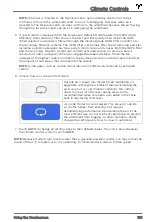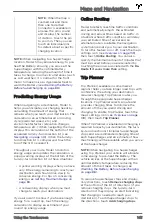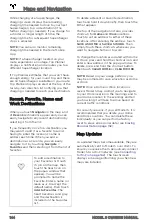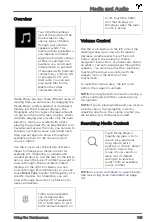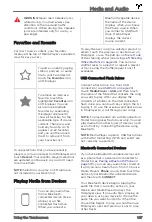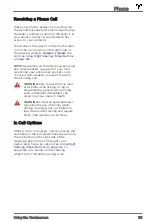
To direct the flow of air inside Model S, move
the interior vents up, down, or from side to
side.
NOTE:
You can direct the outer face level
vents toward the side windows to help
defrost or defog them.
Cabin Air Filter
Model S has an air filter that prevents pollen,
industrial fallout, road dust and other
particles from entering through the vents.
Tesla recommends replacing the cabin air
filter every 2 years.
Tesla recommends replacing the HEPA air
filter (if equipped) every 3 years.
Cabin Overheat Protection
The climate control system can reduce the
temperature of the cabin in extremely hot
ambient conditions for a period of up to
twelve hours after you exit Model S. Touch
Controls
>
Safety & Security
>
Cabin
Overheat Protection
and choose:
•
OFF
: Disable Cabin Overheat Protection.
•
NO A/C
: Only the fan operates when the
cabin temperature exceeds 40° C. This
option consumes less energy but the
cabin temperature may exceed 40° C.
•
ON
: The air conditioning operates when
the cabin temperature exceeds 40° C.
NOTE:
Cabin Overheat Protection operates
only when the energy remaining in the
Battery is above 20%.
WARNING:
Never leave children or
pets in the vehicle unattended. Due to
automatic shut-off or extreme outside
conditions, the inside of the vehicle
can become dangerously hot, even
when Cabin Overheat Protection is
enabled.
Climate Control Operating Tips
• When you use the mobile app to turn on
the climate control system, it
automatically turns off after four hours or
if the charge level drops to 20%. To cool
or heat the cabin for a longer period, you
must turn it on again.
• To conserve energy, turn on Range Mode
to limit the power of the climate control
system (touch
Controls
>
Driving
>
Range
Mode
). Cabin heating and cooling may be
less effective, but you can use seat
heaters to provide warmth in colder
climates.
• If the climate control system is louder
than you prefer, manually reduce the fan
speed.
• In addition to cooling the interior, the air
conditioning compressor also cools the
Battery. Therefore, in hot weather, the air
conditioning compressor can turn on even
if you turned it off. This is normal because
the system’s priority is to cool the Battery
to ensure it stays within an optimum
temperature range to support longevity
and optimum performance.
• Even when not in use, you may hear
Model S emit a whining noise or the
sound of water circulating. These sounds
are normal and occur when the internal
cooling systems turn on to support
various vehicle functions, such as
maintaining the 12V battery and balancing
the temperature of the high voltage
Battery.
• To ensure the climate control system
operates efficiently, close all windows and
ensure that the exterior grill in front of the
windshield is free of ice, snow, leaves, and
other debris.
• In very humid conditions, it is normal for
the windshield to fog slightly when you
first turn on the air conditioning.
Climate Controls
137
Using the Touchscreen













